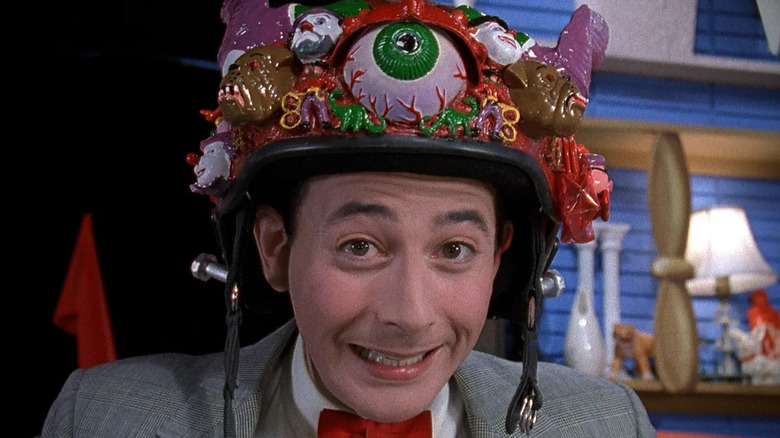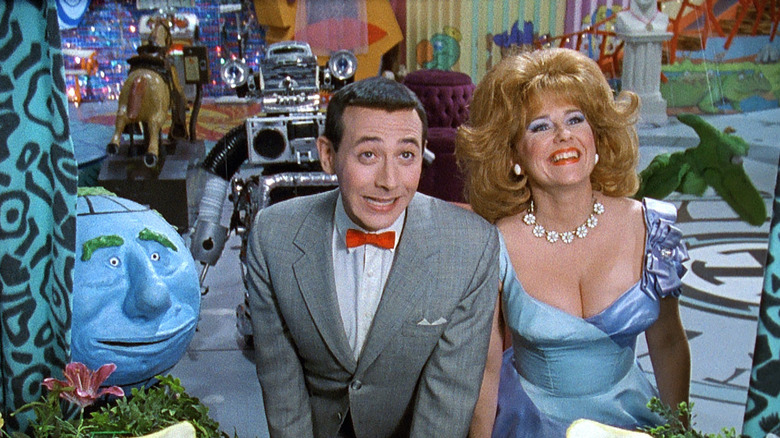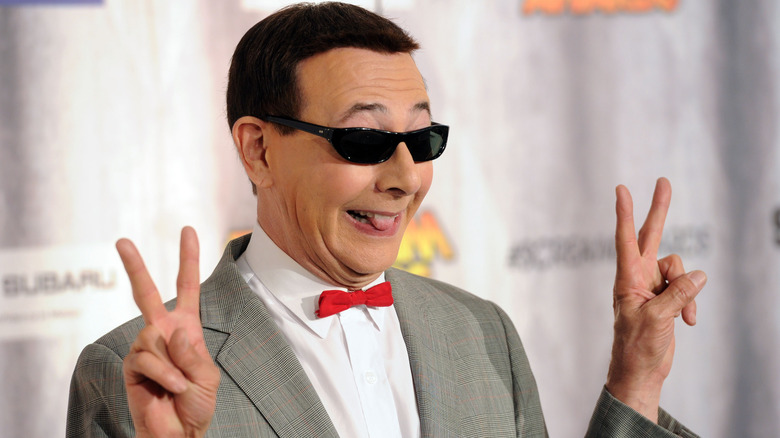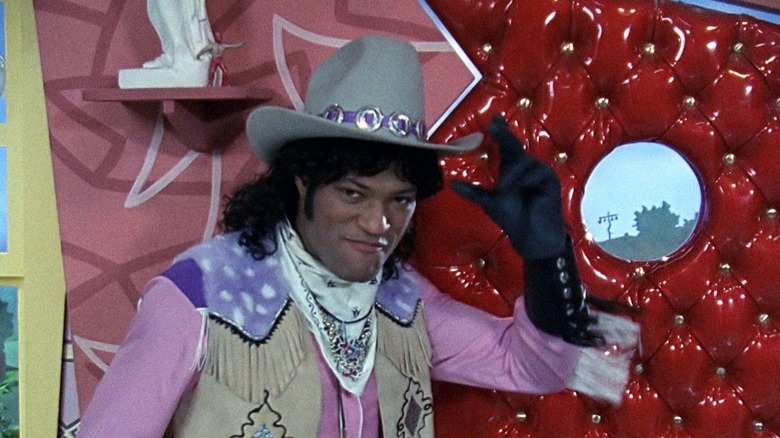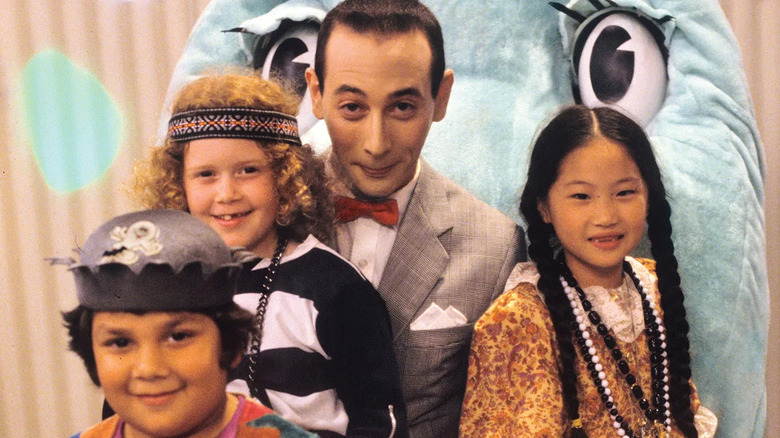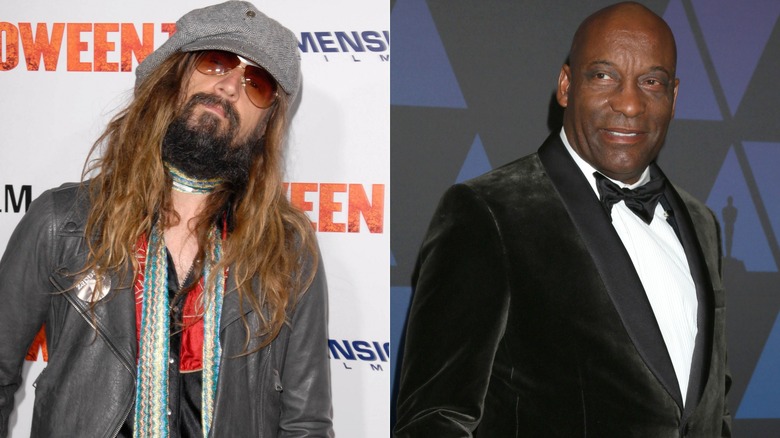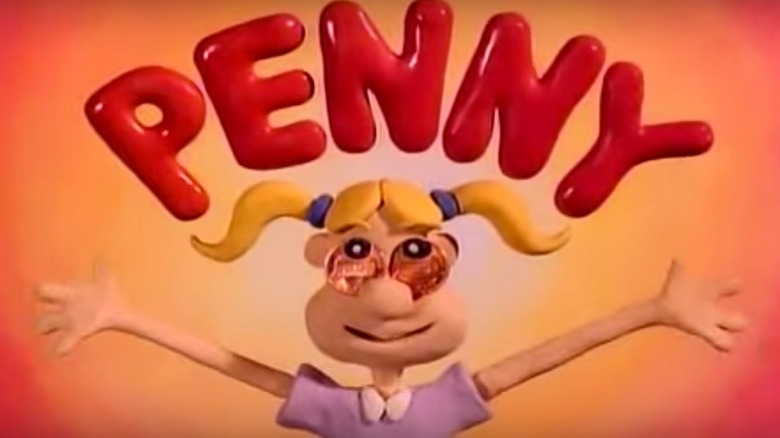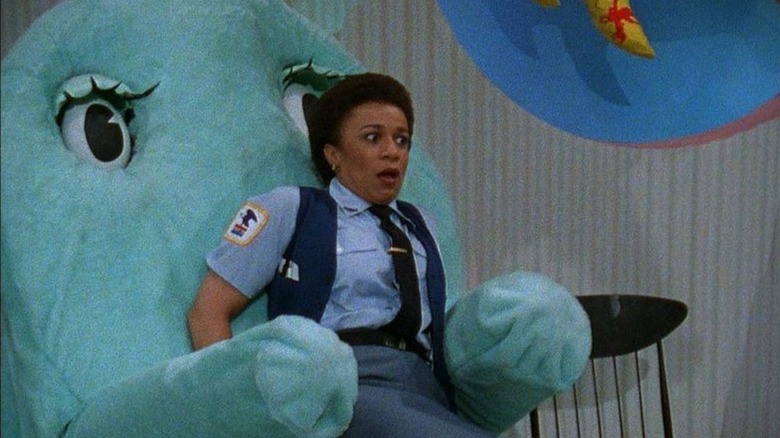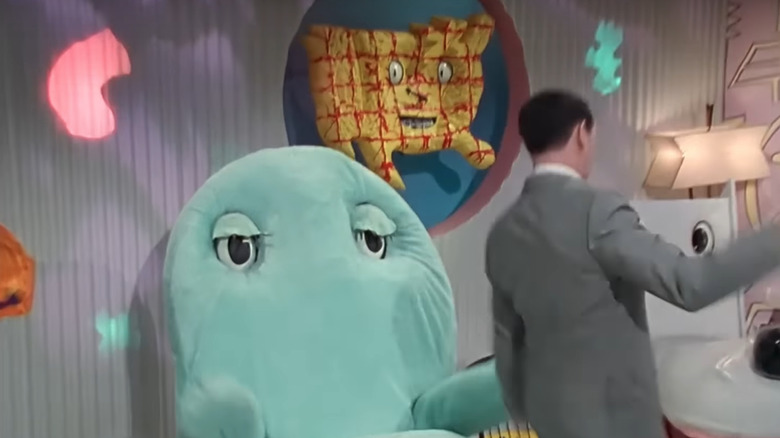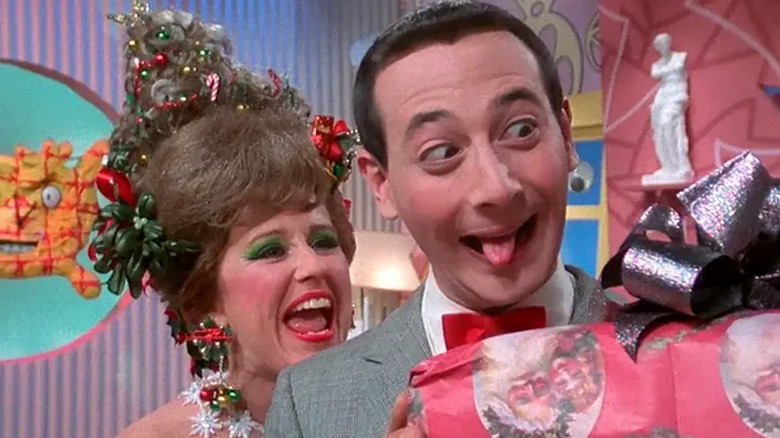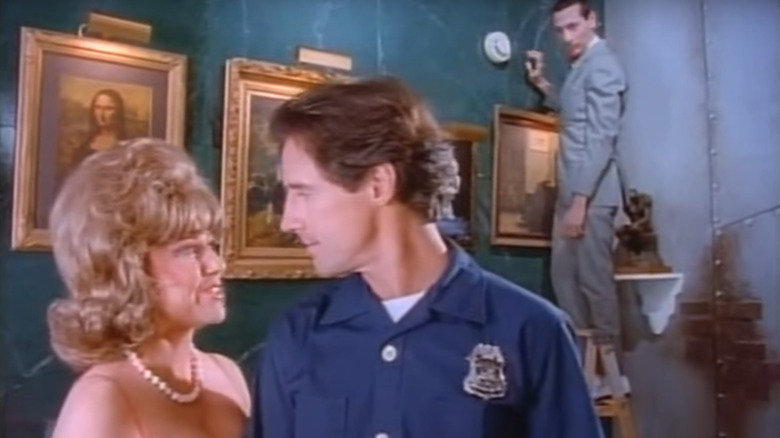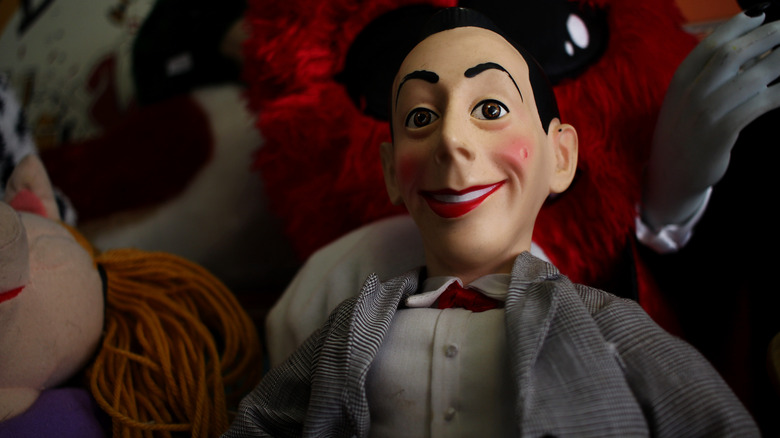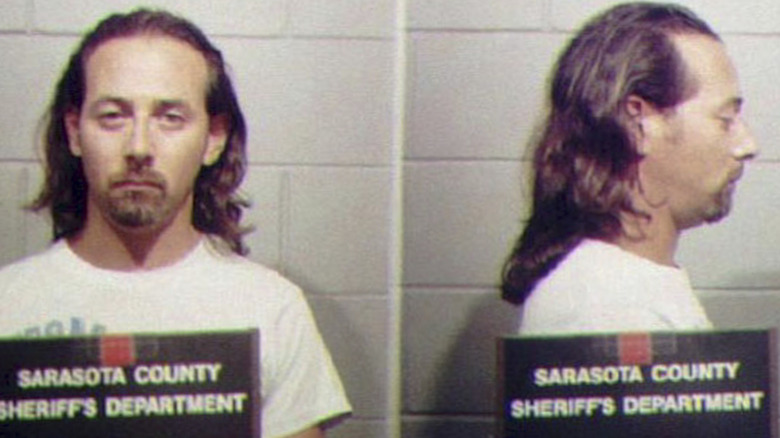The Untold Truth Of Pee-Wee's Playhouse
Following the success of the 1985 movie "Pee-wee's Big Adventure," CBS asked Paul Reubens to develop a Saturday morning series for his Pee-wee Herman character. Inspired by material from the more adult-skewing Groundlings stage show "The Pee-wee Herman Show," "Pee-wee's Playhouse" delighted kids with comedy so absurd and creative that even grown-ups found themselves captivated and getting up early to watch the show themselves. After running for five seasons from 1986 to 1990, its legacy was nearly overwhelmed by scandals in Reubens' personal life. Today, it's remembered fondly, the sort of show those who grew up with it want to pass on to their own children.
In the formulaic wasteland of '80s children's programming, you'd think making such a one-of-a-kind show would take a genie's wish, but no such magic was needed — only a willingness to take risks and get really, really silly. This article will examine some of the real stories behind the making of this comedic cultural phenomenon. You might be surprised by just how many artists you know and love today launched their careers working at the Playhouse!
The era's only live-action Saturday morning show
"Pee-wee's Playhouse" was designed as a throwback to and loving parody of an older era of children's programming. In the 1950s, shows like "Captain Kangaroo" and "Howdy Doody" had live-action hosts accompanied by puppets, sometimes with cartoon segments interspersed in the middle. By the '80s, this style was all but extinct. Live-action children's programming still existed in the form of educational shows on PBS, but the Saturday morning blocks on the major networks were completely dominated by cartoons — and mostly cheaply made ones meant to sell toys.
When it premiered in 1986, "Pee-wee's Playhouse" was the only live-action show on CBS's Saturday morning schedule. That same season, NBC was airing reruns of "Kidd Video," which was partially live-action but mostly animated, and ABC continued its ongoing "Weekend Special" anthology series which occasionally included live-action specials. Other than those two debatable exceptions, "Pee-wee's Playhouse" was the sole live-action program among the Big Three networks' children's lineups. CBS sought to distinguish itself from the competition, giving the series a budget on par with the era's primetime sitcoms and making sure the animated segments were of a much higher quality than the Saturday morning standard.
Reubens rarely broke character while doing press
As was the case in his 1985 breakout film "Pee-wee's Big Adventure," Pee-wee Herman was credited as playing "himself" in "Pee-wee's Playhouse." The Pee-wee Herman character was both a work of performance art and a vehicle for privacy, and Reubens did the majority of his press for both "Pee-wee's Big Adventure" and "Pee-wee's Playhouse" in character as the lovable manchild (one notable exception where Reubens spoke to the press as himself: when addressing The New York Times ahead of the "Playhouse" premiere). What "in character" necessarily means can be somewhat vague; the actor's mother, Judy Rubenfeld, told Rolling Stone in 1987, "I'm not sure where Paul ends and Pee-wee begins."
That Rolling Stone piece provided a number of examples of how confusing the line between actor and character could be. The writer, T. Gertler, was told he "would be talking to Pee-wee, but he wouldn't be using his Pee-wee voice." Gertler was prohibited from asking Pee-wee about his two different identities, only for Pee-wee to bring it up himself, saying, "The problem, to me, is that I have two names, and beyond that, there's not much of a story. This feels more right. I'm able to do all the things I want to do with this arrangement much better. There are so many things I would like to do, so many people I probably am, that it becomes a lot less complicated for me."
Laurence Fishburne's dark Cowboy Curtis audition
Today, Laurence Fishburne is more likely to be associated with his dramatic roles in "The Matrix" or "John Wick" series than with Cowboy Curtis from "Pee-wee's Playhouse." Funnily enough, Fishburne's initial audition for Curtis had more of that Morpheus-style toughness — a bit too much at first, according to the actor's recollection of the audition on "Conan" in 2018.
"When I auditioned for [Cowboy Curtis], I actually went in and did a whole ... serious gunslinger kind of thing," Fishburne said. "I was channeling Yul Brynner from the old 'Westworld' movie." Reubens and John Paragon (writer, director, and Jambi/Pterri actor) were reportedly taken aback by the sheer intensity and asked him to redo the audition with a lighter touch. Not realizing he was auditioning for a comedy show makes for a great self-deprecating story on talk shows, but for what it's worth, Reubens recalled the audition rather differently to The New York Daily News, saying Fishburne was "fantastic" and "just nailed it."
Natasha Lyonne's first acting credit
Watching "Pee-Wee's Playhouse" today involves recognizing a lot of actors who went on to do more big things later, including Laurence Fishburne, Phil Hartman, and S. Epatha Merkerson. But there's one famous face you might not instantly recognize, given that she was only 6 years old at the time of filming: Natasha Lyonne. Yes, the star of "Russian Doll" and "Poker Face" had her first credited acting role as Opal, a member of the Playhouse Gang in "Pee-Wee's Playhouse" Season 1 — and she still has basically the same fashion sense now as she did them.
This is a credit Lyonne takes pride in. Speaking to Entertainment Weekly in 2018, she said, "Nothing makes me feel legitimately cool quite so much as the fact that I was on that show." She stayed in contact with Reubens throughout the years, mentioning in another Entertainment Weekly video that he "sends the best gifs in the biz." After Reubens' death, she posted on Twitter, "Love you so much, Paul. One in all time. Thank you for my career & your forever friendship all these years & for teaching us what a true original is."
Rob Zombie and John Singleton worked on it
In the tradition of George Romero working on "Mr. Rogers' Neighborhood" before directing "Night of the Living Dead," two very different well-known filmmakers started off their careers as production assistants on "Pee-wee's Playhouse": Rob Zombie and John Singleton.
Zombie had already started his band metal White Zombie by the time he started his "Pee-wee" PA job, but they were by no means successful out of the gate. It wasn't until White Zombie's third studio album, "La Sexorcisto: Devil Music Volume One," that they finally found sales success. Rob Zombie became a solo musical act in 1998, before shifting his main creative focus to filmmaking in the 2000s.
Singleton made his big breakthrough as a director in 1991 with "Boyz n the Hood," for which he became the youngest ever and first Black nominee for best director at the Academy Awards. While you're not gonna find any stylistic similarities between "Boyz n the Hood" and "Pee-wee's Playhouse," working on "Pee-wee" did introduce Singleton to Laurence Fishburne, who was an early fan of Singleton's screenwriting and went on to star in several of his films.
Penny's creators made Hey Arnold and Wallace & Gromit
One of the most notable recurring animated segments in "Pee-wee's Playhouse" followed Penny, a girl with pennies for eyes (voiced by Avriel Hillman) whose simple explanations for everyday activities were illustrated via wacky claymation. These cartoons, initially inspired by a request to feature more female characters in "Pee-wee's Playhouse," were created by two figures who were highly influential for the future of animation: Craig Bartlett and Nick Park.
Bartlett went on to create "Hey Arnold!" for Nickelodeon as well as "Dinosaur Train" and "Ready Jet Go!" for PBS Kids. The character of Arnold was first created while Bartlett was playing around with the claymation techniques used for "Penny," making a few shorts and comics with the football-headed boy that eventually got the interest of Nicktoons producer Mary Harrington. While Bartlett stepped away from stop-motion, Park went on to become one of the most celebrated artists in the medium, creating the "Wallace & Gromit" and "Creature Comforts" series at Aardman Animation and winning four Academy Awards.
S. Epatha Merkerson had trouble not laughing on set
Reba the Mail Lady, played by future "Law and Order" star S. Epatha Merkerson, was only character in "Pee-Wee's Playhouse" who could generally be considered a "normal" person, confused by and a little bit scared of Pee-wee and his strange friends. Playing the straight woman in a cast full of clowns is an acting challenge, and one that Merkerson struggled with at first.
Speaking on the bonus features of the "Pee-wee's Playhouse" Blu-ray collection, Merkerson recalled that the mere sight of Reubens in his Pee-wee outfit made it hard not to laugh. She said that from the first time they met on set, "From that point on I know that Paul knew that he could make me laugh. And he tortured me ... At one point the director came over and said in this very low voice, I need to get this shot. How do I get this shot?' And I said, 'Well then I can't look at Paul ...' I really thought I was going to lose the job!" (via Mental Floss). Either the director came up with some really clever blocking to avoid her having to look at Pee-wee, or Merkerson deserved an award for managing to keep a straight face in that moment, because she did not lose the job.
Cast and set changes between seasons 1 and 2
Compare episodes from the first season of "Pee-wee's Playhouse" and the four subsequent seasons, and you'll notice many differences. Characters such as Captain Carl (Phil Hartman), Tito (Roland Rodriguez), Mrs. Steve (Shirley Stoler), and Dixie (Johann Carlo) disappeared after Season 1, while the King of Cartoons changed actors from Gilbert Lewis to William H. Marshall, and the Playhouse Gang kids were rotated out. There were differences in the design of the Playhouse as well: Pee-Wee's creepy toy shelves got replaced with Clockey, while part of the floor became sentient as Floory.
New shows often go through adjustments between seasons. In the case of "Pee-wee's Playhouse," there's actually a simple explanation for all these cast and set design changes: The show was produced in New York for Season 1 before making the move to Los Angeles for the rest of its run. The change in location meant not everyone was able to make the jump across coasts (Hartman in particular had to stay in New York for "Saturday Night Live"), but it allowed for a more spacious set where designers Wayne White, Gary Panter, and Ric Heitzman got to really hone their eccentric aesthetic.
Season 3 was cut down by the 1988 WGA strike
In 1988, the Writer's Guild of America went on strike. Lasting 22 weeks, the longest strike in the WGA's history, it resulted in improved residuals for cable programs as well as improvements in creative rights for screenwriters. The length of the strike left TV networks stretched extremely thin in terms of new material. "Pee-wee's Playhouse" was one of the shows affected by the strike.
While all the other seasons had 10 to 13 episodes, Season 3 only contained two normal episodes (held over until the following season for broadcast) plus the hour-long "Pee-wee's Playhouse Christmas Special." Those seeking new Pee-wee material in 1988 had to make do with just the special and the character's second movie, "Big Top Pee-wee." The latter was widely considered a disappointment, but the former is a treat packed with an enormous lineup of guest stars to join in the festival cheer: Frankie Avalon, Annette Funicello, Charo, Grace Jones, k.d. lang, Dinah Shore, Little Richard, Cher, the Del Rubio Triplets, Magic Johnson, Princess Zsa Zsa, Whoopi Goldberg, Oprah Winfrey, Joan Rivers, and the UCLA Men's Choir.
The CBS censors requested very few changes
Before the likes of "Ren and Stimpy" or "Animaniacs" took things to the next level, "Pee-Wee's Playhouse" was pushing the envelope for how much adult-oriented innuendo you could get away with on children's television. Given just how many risque gags made it on the air, it's surprising to find out that the CBS standards and practices department had very few objections to the show's content — and even more surprising to find out one of those examples wasn't even dirty.
As detailed in The AV Club's 2006 interview with Reubens, the most unexpected network note came from the first episode: "You can't stick that pencil in that potato, because pencils are sharp, and you might encourage kids to stab things." A scene where Miss Yvonne said she had a smoke detector "in my bedroom, above the bed" aired once, but the location was changed to the much less suggestive "kitchen" in reruns. Another scene, where Pee-Wee was in the bathroom, had to change its sound effects so the peeing sound was less loud. "I think in 45 episodes, there were only maybe three other changes they ever asked for," Reubens said.
Rejected merchandising ideas
Given how expensive the show itself was to produce, much of the financial success of "Pee-wee's Playhouse" came from merchandising. As he was with the show itself, Reubens was serious about the quality of the merchandise — reportedly requesting eight revisions of the official Pee-wee doll before it hit stores. His personal merchandising instincts, however, didn't always match the interests of manufacturers — or of his young audience, for that matter.
In a 1999 Vanity Fair profile, Reubens described one Pee-wee tie-in product that never made it to shelves: Ralston Purina Pee-wee Chow cereal. "The commercial," he said, "was going to be a '50s mom shaking the cereal into a bowl and then putting it on the floor — the kids were gonna come up on all fours and eat it like dogs. It tasted just like Trix, which was my favorite cereal when I was a kid, and it had more of everything good in it than any cereal on the market at the time. No sugar, sweetened with fruit juice, had all kinds of extra vitamins. It was really good for you, and everything was going fine — until at the last minute they did a blind taste test and kids hated it." A line of Miss Yvonne wigs also failed to come about, despite Reubens' enthusiasm for the idea.
It was NOT canceled due to the theater scandal
There's a common misconception that "Pee-wee's Playhouse" was canceled as a result of Paul Reubens' July 1991 arrest on charges of "indecent exposure" in an adult movie theater. It is true that reruns of the series were pulled from CBS's schedule and merchandise was removed from stores, and in the current colloquial sense of the term, you could argue that Reubens himself was temporarily "canceled" given the negative impact the scandal had on his career and reputation. However, "Pee-wee's Playhouse" had already premiered its final episode over seven months before the arrest.
Though the show was still popular in Season 5, Reubens personally decided that he needed to take a sabbatical and end "Pee-wee's Playhouse" on a high note. He was burned out on doing so much work on the show, as well as uncertain what his career could be beyond the Pee-wee Herman persona. The series finale, "Playhouse for Sale," saw the Playhouse residents getting scared upon finding a "For Sale" sign outside — only to realize it was from a lemonade stand and that the Playhouse itself wasn't in danger. The episode ended with Pee-wee telling viewers, "The playhouse will always be here for everyone to play in, forever and ever and ever. On that, you have my word" — "word" being the episode's secret word of the day, giving everyone one more excuse to SCREAM REAL LOUD!
